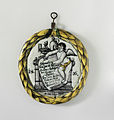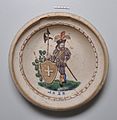Johann Heinrich Egli (painter)
Johann Heinrich Egli (* 1776 in Nussberg ; † October 3, 1852 ) was one of the most important tile stove painters of the first half of the 19th century in German-speaking Switzerland due to his extensive activities in the cantons of Zurich , Aargau , Basel-Landschaft , Lucerne , Solothurn and Bern .
Origin and education
Johann Heinrich Egli was born in Nussberg near Winterthur in 1776 . Where he received his training as a faience and stove painter, who trained him and prepared him for the profession, is unknown. At that time, however, Winterthur was a center of furnace construction. His professional career as a furnace painter apparently began in Elgg in the canton of Zurich, also not far from Winterthur. There he can be traced back to 1806 as a painter for Elgger Hafner's room sign and for the cover picture of the handicrafts book created in the same year. He also painted tiled stoves for Elgger Hafner Salomon Spiller between 1806 and 1816 .
Between 1811 and 1817 Egli also worked for the stoner Rudolf Kuhn from Pfäffikon ZH . This collaboration also resulted in a “cache-pot” made of faience, dated and signed in 1812 .
Egli painted his tiles from the style of the Empire or of classicism and Biedermeier . As a paint he used on the smooth, non-relief faience tiles ( leaf tiles , corner tiles , cornice tiles ) predominantly a manganese violet typical of the time. Only in very rare cases did he also venture multi-colored designs. A few bowls preserved in museums show that he occasionally painted vessels for decorative purposes in addition to the tiled stoves.
Residence and activity in Aarau
Probably around 1813 Egli relocated his sphere of activity mainly to Aargau and settled in Aarau . The reasons for this are unknown. In Aarau he married Salomea Hagenbuch, a native of Aarau, in 1816. The list of stove manufacturers for whom Egli worked includes, on the one hand, the stoves of the city of Aarau due to his place of residence, but also extends to Burgdorf and Bern in the west. He worked in Aarau from 1813 to at least 1835 for Johann Jakob Andres older (1770-1839) and Johann Jakob Andres younger (1775-1839). There are also tiles in 1842 and 1846 for Gottlieb Andres (presumably Friedrich Gottlieb older, 1816–1870), 1850 for Johann Andres, 1841 for Jakob Friedrich Andres (life data unknown), 1848 for Friedrich Andres Bodmer (life data unknown), 1815 for Andreas Ehrsam (1792–1841), 1831 and 1842 for Daniel Ehrsam (1802–1859), 1818 and 1835 for Joh. Jakob Fisch (1771–1836), 1820 for (Beat) Daniel Fischer (1779–1843), 1831 for Samuel Richner ( 1797–1861) and in 1850 for Friedrich Henz (1811–1877). Also in Zofingen in Aargau, he worked for the Johannes Zurlinden pottery at least in 1813.
Activities in the cantons of Bern and Aargau
In the early phase of his work in Aargau, he also had business relationships with Burgdorf and Bern . In Burgdorf, Egli worked for the potter Joh. H. Aeschlimann (pottery certificate 1804–1848). The Bernese stoner S. Lager also had Egli painted for himself, as evidenced by the remains of a stove that is now kept in the building material depot of the canton of Bern's monument preservation department. The signed stove was originally on the 3rd floor of Kramgasse 22 in Bern. Another stove from S. Lager painted by Egli is said to be at Alt-Falkenstein Castle, Klus SO. In addition, the Rittersaalverein Burgdorf kept under inv. No. IV-1268 a complete oven of unknown provenance with the signature "Frau Wwe. Jenner Hafnerin in Bern and K. Mangold, master craftsman, Egli painter". In view of Egli's activities in Burgdorf and Bern, the stove from the first floor of the Bären Inn in Utzenstorf BE, dated 1823, does not necessarily have to be attributed to an Aarau workshop.
In Langenthal BE, Egli also worked for the potter Johannes Staub, who ran the workshop there from 1803 to 1824. This can be proven archivally or by means of standing ovens and preserved individual tiles. The employment of Eglis extended beyond a first economic crisis in 1819 and was continued under the son Johannes Staub (1801-1847?) Until at least the 1830s.
Between 1834 and 1848 Egli also worked for the stoner Wolfgang Schmid in Gipf-Oberfrick AG, who combined Eglis faience tiles with leaf tiles with stencil decoration, among other things. Egli also worked at least in 1829 for the stewers of the Anderegg family in Wangen an der Aare BE, but due to the lack of images, it is hardly possible to provide an overview. The same applies to his work for the Hafner Sommerhalder in Burg bei Menziken AG.
Work for Johann Jakob Grütter in Seeberg
The work for Johann Jakob Grütter in Seeberg BE , which covers at least the period from 1831 to 1843, is somewhat better documented. There are also simple tiles decorated with vases and garlands, as are so typical of the Aarau production painted by Egli. From 1831 onwards, however, there were also extremely sophisticated, large-format, long rectangular tiles with long sayings and sometimes scenic representations. The oven in the Burgdorf Castle Museum and one in Melchnau BE also belong to this group . Together with long sayings or poems, the depictions represent patriotic themes (“Swiss election slogan”) or philosophical-religious and moralizing themes (“Our life is like the seasons”, “Souvenirs”, “Diligence and reward”, “The fleeting time”) . The latter topic in particular is still relevant today. Egli has left the following text on the tile:
Pick roses when they bloom! Tomorrow is not today.
Let not an hour escape! Time is fleeting.
Today is an opportunity for enjoyment and work.
Who knows where to be tomorrow? Time is fleeting.
Postponing a good deed has often repented.
To live actively is my advice; Time is fleeting.
Motifs and themes on stove tiles Johann Heinrich Eglis
Johann Heinrich Eglis tiled stove paintings stylistically use the motifs of the Empire and Biedermeier . Small-format landscapes, flower garlands, flower vases or vase-shaped, lidded urns, scrolls with patriotic, religious, moralizing or friendship sayings fully correspond to the zeitgeist, which is oriented towards domestic comfort and strict morality. The urns were considered both as a symbol of remembrance of the dead and as gifts of friendship or love, as symbols of eternal bond.
Patriotic motifs, which particularly emphasize the peasant class, can be found alongside national-Swiss topics such as B. the “ Rütli oath ” or the “Swiss election slogan” on two ovens by Johann Jakob Grütter from Seeberg BE, dated 1832 and 1836 respectively. Cantonal and national daily politics are repeatedly reflected. In April 1832, for example, Egli wrote on a stove tile “Who can be happy in Basel now, there is no Bürdertreu now”. This sentence refers to the armed conflicts that resulted in the two cantons of Basel-Stadt and Basel-Landschaft arose between April and September 1832. At about the same time he judged the canton of Zug : "The Zuger Ländle is all well and good, but there is still a lot missing there". In this case, however, it remains unclear what Egli's criticism is referring to (Zug as part of the Catholic Sonderbund ?), As the tile is not dated.
The Aargau constitutional struggle of 1840/1841 is also reflected in a stove made by the potter Wolfgang Schmid from Gipf-Oberfrick . Possibly it can be concluded from this that Egli belonged politically to the liberal and reform-minded people of the Aargau who, under the leadership of the radical Augustin Keller, changed the constitution that year and a. repealed equal representation of the Protestant majority and the Catholic minority in the cantonal authorities. The tile inscription "Aargau was already free, before the Landsturm came here" probably belongs in the same historical context.
The emphasis on patriotic issues and the relatively frequent emphasis on "brotherly love" are probably to be seen as a sign of political uncertainty in the period between the liberal cantonal constitutions of around 1830, the parade trains and the federal treaty of 1848.
In connection with religious sayings, such as B. "Heaven is man's goal ...", Egli u. a. a 1815 printed in Munich German Vespers prayer first for the Catholic parish Sindelsdorf ... back. It is possible that Egli was also a particular admirer of the pedagogue Johann Heinrich Pestalozzi (1746–1827), but there are two references to this important Swiss reformer of child rearing. A tile dated 1831 is dedicated to “Dem noble Schulman and friend Pestaluz”. A tile from the collection of the Rittersaalverein Burgdorf, probably made around the same time, proclaims "Heinrich Pestaluz, a man who did a lot of great things!"
The great price increases and famine of 1816/1817 are reflected twice on stove tiles painted by Egli. On a tile painted for the potter Rudolf Kuhn from Pfäffikon, he left Zurich's grain market prices from that year. A tile on the stove from the Löwen inn in Utzenstorf BE names the Bernese prices from 1817, when the eruption of the Tambora volcano on the island of Sumbawa in Indonesia in April 1815 in the summer of 1816 led to an unusual wave of price increases across Europe. And Egli also dealt with another food catastrophe of European proportions, which also affected Switzerland. On a tile dated 1847 you can find "That the potatoes sick, in every country, Gab Jammer, and Noth, in every state!". A native of Mexico, and probably entrained via the USA fungus that Kartoffelkrautfäule triggers, destroyed first, from 1845, the livelihoods of the Irish peasantry, occurred simultaneously in the Netherlands and in Belgium destroyed from 1847 also in Switzerland the potato harvests.
The tiled stoves painted by Johann Heinrich Egli until his death in 1852 shaped the tiled stove landscape of the Bernese Aargau, the neighboring canton of Lucerne, the eastern Aargau, the Fricktal and parts of the cantons of Basel-Land and Zurich. His tiles were evidently so sought-after or “style-forming” that their decorative motifs e.g. B. in Schinznach by the potter Ulrich Joho, in Thun by the potter Friedrich Krebser and in Langenthal by Johann David Staub. It remains uncertain whether Egli also worked in Jean-Baptiste Nuoffer's workshop in Friborg or whether his “style” was copied there in the 1820s.
literature
- Andreas Heege: Langenthal, St. Urbanstrasse 40–44. Hafner Staub and their workshop. Archeologie Bern / Archeologie bernoise 2011, 209–288.
- Andreas Heege: A tiled stove by Johann Jakob Grütter, Hafner from Seeberg, and Johann Heinrich Egli, stove painter from Aarau. Burgdorfer Jahrbuch 81, 2014, 21–40.
- Andreas Heege: Of masterpieces, stove tiles and pipes - The Hafner Aeschlimann in Burgdorf. Burgdorfer Jahrbuch 84, 2016, 19–48.
Web links
- http://independent.academia.edu/AndreasHeege/Papers/1116563/Langenthal_St._Urbanstrasse_40-44._Die_Hafner_Staub_und_ihre_Werkstatt
- http://www.academia.edu/5261678/Ein_Kachelofen_von_Johann_Jakob_Gr%C3BCtter_Hafner_aus_Seeberg_und_Johann_Heinrich_Egli_Ofenmaler_aus_Aarau
Individual evidence
- ↑ Ludwig Rochus Schmidlin : Dr. Friedrich Xaver Odo Fiala, Bishop of Basel: a picture of life, based on the writings of the eminent and eternal and based on other documented sources. Vereindruckerei Solothurn, Solothurn 1890, p. 263.
- ↑ For all sources for the following statements, see Heege 2011.
| personal data | |
|---|---|
| SURNAME | Egli, Johann Heinrich |
| BRIEF DESCRIPTION | Swiss tiled stove painter |
| DATE OF BIRTH | 1776 |
| PLACE OF BIRTH | Nussberg |
| DATE OF DEATH | October 3, 1852 |
| Place of death | Aarau |





















